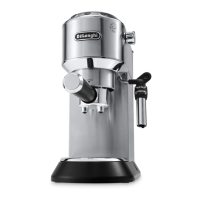12
5. Replace the nozzle, move the ring downwards and put the
cappuccino maker back on the connection nozzle, turning
it and pushing it upwards until it is attached.
12. COOLING THE BOILER
To make coee again immediately after frothing milk, the boil-
er must rst be cooled or the coee will be burnt. Proceed as
follows:
• place a container under the cappuccino maker;
• open the steam dial to deliver hot water and cool the
boiler;
• hot water delivery is interrupted automatically when the
boiler is cool. When the pump stops operating and no more
water is delivered, close the steam dial.
The coee maker is now ready for use.
13. HOT WATER
1. Press the ON/OFF button (g. 3) to turn the appliance on.
Wait for the coee lights to come on steadily.
2. Place a container under the cappuccino maker.
3. Turn the dial to the position. Hot water is delivered
from the cappuccino maker.
4. To stop hot water delivery, close the dial and press any
button.
You should not deliver hot water for more
than 60 seconds.
14. CLEANING
14.1 Cleaning the machine
The following parts of the machine must be cleaned regularly:
- drip tray (A9)
- the coee lters (C2, C3 and C4);
- the boiler outlet (A5);
- water tank (A3);
- the cappuccino maker (A15) as described in section "”11.
Cleaning the cappuccino maker after use”;
Important!
• Do not use solvents, abrasive detergents or alcohol to clean
the coee machine.
• Do not use metal objects to remove encrustations or coee
deposits as they could scratch metal or plastic surfaces.
•
If the appliance is not used for more than one week, before
using it again, we strongly recommend you perform a rinse
cycle as described in section “6. rst use”.
Danger!
• While cleaning, never immerse the coee maker in water.
It is an electrical appliance.
• Before cleaning the outside of the appliance, turn it o,
unplug from the main socket and allow to cool.
14.2 Cleaning the drip tray
Important!
The drip tray is tted with a level indicator (red) showing the
level of water it contains (g. 20). Before the indicator protrudes
from the cup tray, the drip tray must be emptied and cleaned
otherwise the water may overow the edge and damage the
appliance, the surface it rests on or the surrounding area.
1. Remove the drip tray (g. 21).
2. Remove the cup tray (A7), empty the water and clean the
drip tray with a cloth, then reassemble the drip tray. Ex-
tract the mugs or glasses tray (A10), clean with water, dry
and put back in the machine;
3. Put the drip tray back in place.
14.3 Cleaning the coee lters
Clean the coee lters weekly:
1 and 2 cup lters
1. Extract the perforated lter by pulling the tab (g. 22);
2. Rinse the lters under running water (g. 23);
3. Make sure the holes are not blocked. If necessary, clean
with a pin (gs. 23 and 24);
4. Place the perforated lter in the lter housing and press as
far as it will go.
Pod lter
Rinse under running water. Make sure the holes are not blocked.
If necessary, clean with a pin (gs. 23 and 24).
14.4 Cleaning the boiler outlet
After every 200 coees, rinse the boiler outlet by delivering
about 0.5 l of water from the boiler outlet (press the coee but-
ton without using ground coee).
14.5 Other cleaning operations
1. Do not use solvents or abrasive detergents to clean the cof-
fee maker. Use a soft damp cloth only.
2. Clean the lter holder cup.
14.6 Cleaning the water tank
1.
Clean the water tank regularly (about once a month) and
whenever you replace the water softener lter (C6, *if pro-
vided) with a damp cloth and a little mild washing up liquid;
2. Remove the lter (*if present) and rinse with running
water;
3. Put the lter (*if provided) back in the appliance, ll the
tank with fresh water and replace the tank;

